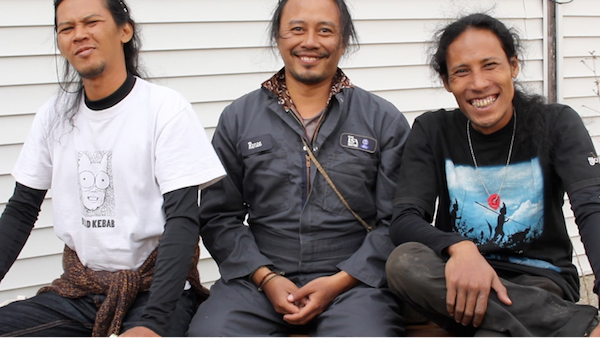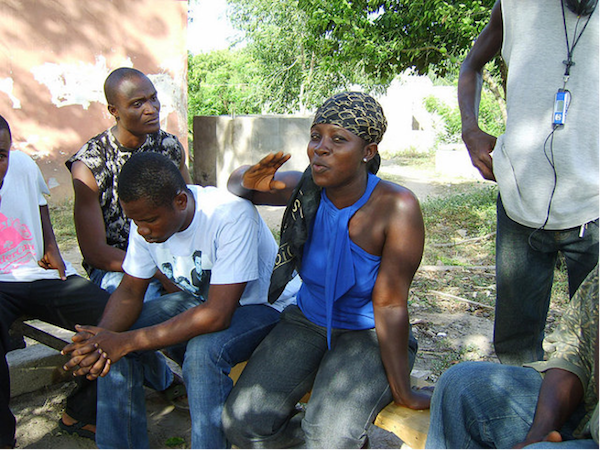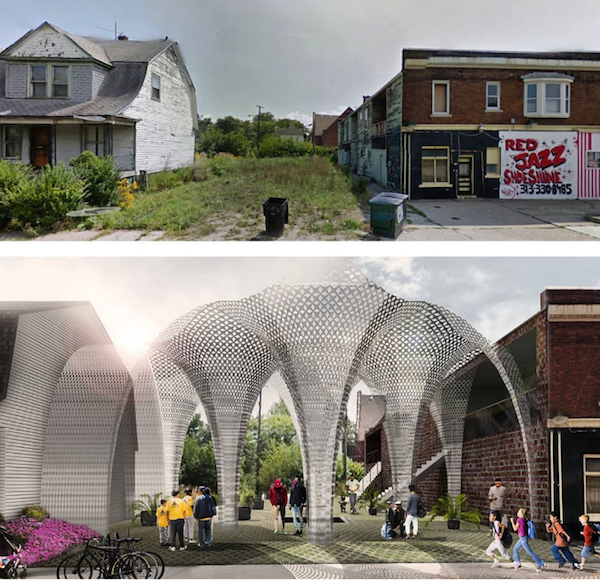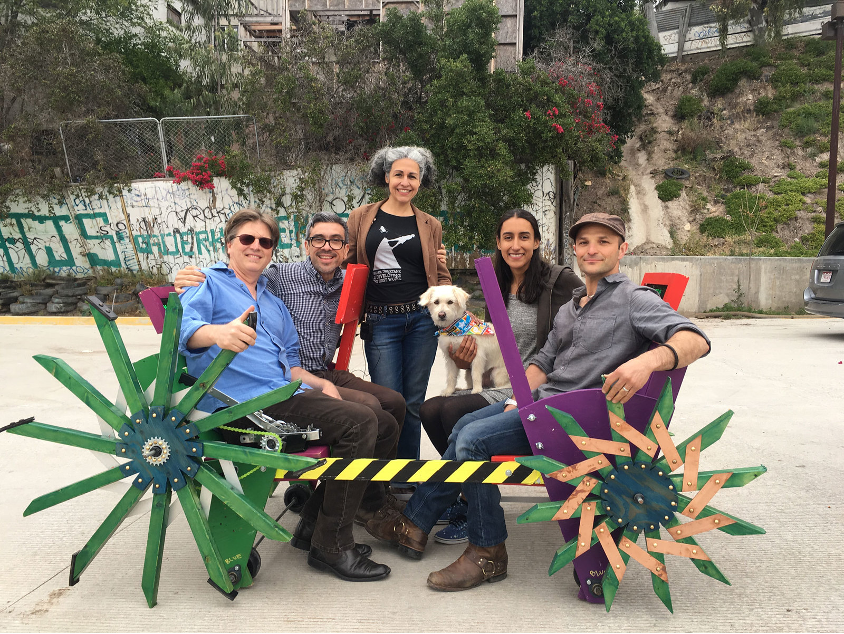(Photo: Ghana ThinkTank and ToroLab in their interactive cart at the U.S.-Mexico border)
Recently members of the international collective Ghana ThinkThink and Indonesia-based think tank, Lifepatch, joined us for a discussion about rethinking traditional notions of expertise in international development.

For over 14 years, Ghana ThinkTank has created projects that flip traditional power dynamics by asking people living in the “developing world” to intervene into the lives of the people living in the so-called “developed” world. The think tanks—which include a group of bike mechanics in Ghana, a rural radio station in El Salvador, Sudanese refugees seeking asylum in Israel, an artist collective in Iran, and a group of incarcerated girls in the Boston penal system, among others—propose solutions to problems collected from “developed” countries, which are then implemented. The collective was founded in 2006 by artists Christopher Robbins, John Ewing and Matey Odonkor; Maria del Carmen Montoya joined in 2009.
We sat down with Christopher Robbins (CR) and Maria del Carmen Montoya (CM) to learn more about the insights they’ve gleaned from their work, which include invaluable advice for people or organizations working in development.
Why did you start Ghana ThinkTank?
CR: We all worked on the fringes of international development, where we encountered the hubris of the west. Matey grew up in Ghana in a town that received aid and later worked for an NGO. I worked in Serbia, Fiji and West Africa, and I experienced the feeling of being someone who supposedly had solutions for a culture that I hadn’t grown up in, and saw the dangers of being given power that I hadn’t earned in any way. Returning to the U.S., I wanted to show people in “my culture” what it looks like to have others impose their “goodwill” on them. I thought: how can we flip this? We all came into the project from related, though not identical, points of view.

CM: I worked as an interpreter, often in Mexico, Guatemala and El Salvador. I was trying to create intercultural understanding, but faced challenges translating a problem into the mindset and worldview of the other group. I witnessed how often times the hubris and paternalism of the west that poses “west is best” and “white is right,” was missing the point entirely. The other piece that attracted me to Ghana ThinkTank, is flipping power dynamics. The minute you ask for the opinion of someone who has traditionally been framed as a “needy” person, you raise them to a level of being a resource, which has its way of enabling and empowering communities.
Each think tank is unique; how were they formed?
CM: We don’t form think tanks out of nothing; they have a preexisting affinity and relationship that exceeds the project. They come not only with ideas, but a social identity as a team. We also pay the think tanks, which is important because they’re giving their time and expertise. But it’s an organic relationship; they are not employees for the project, but rather expert contributors. We see our relationship as a collaborative one.
CR: The first three think tanks were in Ghana, Cuba and El Salvador, and had evolved from personal contacts we developed while living overseas. We’ve also started to seek think tanks for specific projects. For example, when we were invited to work in the Netherlands, we thought it was important to have think tanks in former Dutch colonies.
What are a few of your favorite projects so far? Why?
CR: In Mitrovica, a divided town in former Yugoslavia, the Serbian and Albanian populations are separated by a river and protected from one another by international troops. We asked both sides to solve each other’s problems from across the river. While initially they were not thrilled that “the enemy” was being asked to solve their problems, they soon realized that they had many similar problems, including things like: “my grandmother is buried over there, but I’m frightened to go.” A group that had not crossed the bridge since the war ended in 1999, came across to work with the other. One of the solutions implemented was a free bus that will take you anywhere so long as it’s on the other side. The best part was that we were eventually kicked out of our own project. They were like “wait why are you here, aren’t we talking to them?” We realized it was a far greater success than anything we’d planned. This loss of control has become a goal for our projects.
The American Riad is an art and housing justice project in Detroit. Artists from Morocco, Indonesia and Syria are working with artists and affordable housing workers in Detroit to rebuild an abandoned street corner around a 2,000 square foot sculpture. This emerged from the Moroccan think tank looking to Islamic urban design and architecture, like Riads, that encourage community gathering, as a solution for the architecture in the U.S., which causes and perpetuates isolationism and individualism.

CM: One of my favorites is a project called “funny, dirty stories,” based on a problem we received when working in Wales. The elderly were being treated like a burden to society and were put away in nursing homes and forgotten. The think tank in Iran suggested that the real problem is that young people don’t feel that they have anything in common with older people. They advised us to collect funny, dirty stories from the elderly and share them with young people to bridge this divide. The stories were then featured in an exhibition in a gallery, where visitors could listen and interact with them.
We also love the border project, which took place between Tijuana and San Diego and addressed one of the biggest problems in the U.S.— immigration policy. We decided to create an immigration think tank on the border crossing itself, which involved people who lived their daily lives on different sides of that problem, including border vigilantes and undocumented workers in the U.S. and recently deported immigrants in Tijuana. In one example, when we asked people what it was like to cross the border every day, they told us about the long lines and the lack of food and covering from the brutal sun. We worked with ToroLab (a Tijuana Art Collective) to design and build a cart that was powered by hand cranks, so that it moved at the pace of walking. We brought it to the border, and gave people an opportunity to sit with these two screens where they could submit their own border problems, and scroll through solutions from the think tanks that we had set up. The problems that were submitted reflected the realities of the hundreds of thousands of people who cross the border every day and were entirely unlike the political rhetoric around the issue.
Why do you think it is important to question and examine the traditional societal hierarchies we’ve established around expertise?
CM: The emphasis on trained and studied expertise makes it impossible to see value in and activate the expertise of lived experience, which is as vital, if not more so, than anything we can learn otherwise. It is also marginalizing people who don’t have the same access to the western educational experience that the so-called experts often partake in.
CR: When we use our embedded, created hierarchies to run projects, we are continuing the same power structures that have caused so much damage in the world, and blinding ourselves to ways of knowing that existed far before these became dominant. We are missing out on great resources of intelligence.
How do you think public art can help us examine power dynamics and foster dialogue across differences?
CR: There is a flexibility in art that is not permitted or expected in almost any other field. I’ve seen villages feel compelled to implement projects even if they think they will be damaging, because they did not want to lose future funding. Donors decide in advance what funds are for and everyone changes what they’re doing to align. In any project, you’re going to learn as you’re doing it and you need to have the flexibility to change. With art, failure is defined differently. If I wasn’t able to steamroll this project in this community, it is not defined as a failure, but rather as learning from your process. We found in art the ability to question and have less prescriptive outcomes.
CM: Art is more about expansiveness and innovation, while in development there’s an adherence to models and a particular history or way of doing things in the past. Art is a more open place where you can move beyond this; it has the capacity to activate the power of the poetic and encourage creative thinking.
If you could give one piece of advice to people or organizations working in development, what would it be?
CR: If you design a project so that people who would be the most impacted are not making it happen, then the project will fail. You want that project to fail, if it is just railroading something that somebody does not want. I’ve learned that with all the power dynamics in place, if you are coming in with aid, you can’t rely on the community to stop or alter a project, and you also can’t rely on yourself to notice. You need to build in stopgaps that cause the project to fail if it’s not being run by the people who it most impacts.
CM: Before you do anything or launch into helping somebody, rather than envisioning them as needy or in need of your help, think about what you might need from them.
To learn more about Ghana ThinkTank, visit their website, or follow them on social media:
Twitter: @GhanaThinkTank
Facebook: Ghana ThinkTank
Instagram: Ghana ThinkTank
